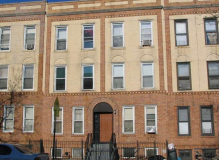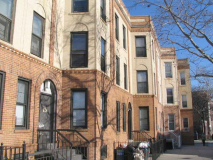It was a deep and dark December as the song goes, and I had just a couple of hours before I lost the light. I decided to walk the scarp that divides Sunnyside and Woodside, through Sunnyside Gardens, and into Astoria…

He’s called the Woodside Doughboy and while there are 9 other figures in NYC, such as the ones in Bushwick and Richmond Hill, Cal Snyder (Out of Fire and Valor) says he’s one of the most-loved.
Mustering Ground
Originally titled “The Returning Soldier,” the statue is perhaps better known for its pedestal inscription “Lest We Forget.”
The monument was commissioned by the Woodside Community Council at a cost of $5,000. Its granite pedestal was designed by C. N. Kent. The sculptor Burt Johnson was born in Flint, Ohio, and lived for a time in Flushing, Queens. Johnson studied with sculptor James Earle Fraser and Louis Saint-Gaudens, brother of the renowned artist Augustus Saint-Gaudens. Johnson received many public commissions from coast to coast, and he also created the doughboy statue for the Flanders Field Memorial (1929) in Manhattan’s Dewitt Clinton Park.
Unlike more active war memorial figures, Johnson’s depiction of the doughboy portrays a somber World War I soldier, with a downcast bandaged head, holding his helmet in front and his gun to the side. The sculptor’s health was failing as the piece was being completed, and he supervised the final work from his wheelchair.
Woodside residents remember that even before the statue was erected local soldiers gathered here at the “mustering ground” before departing to fight in World War I. Ten men who left from this site did not return as they made the supreme sacrifice and gave their lives for their nation. The statue was dedicated on Memorial Day in 1923. The ceremony included music by St. Mary’s Military Band, a rendition of the “Star Spangled Banner” by the children of P.S. 11, the doughboy’s unveiling by Gold Star Relatives, and blessings by ministers from St. Paul’s and St. Sebastian’s Churches.
In 1928, the American Federation of Arts selected the Woodside Doughboy as the best war memorial of its kind. In 1990, the Woodside Doughboy benefited from an extensive conservation, and in 1995 and 1998 the site was upgraded with new plantings and fencing. The improved statue and park remain a neighborhood focal point, where, since the dedication in 1923, community members have gathered at the monument each Memorial Day for patriotic ceremonies. NYC Parks
The evocative Doughboy is a haunting rendition of a man who has survived where his friends didn’t.


Doughboy Park gained a compass rose in its 1990 renovations. The major 4 points are marked with, appropriately enough in a borough with a heady Greek flavor, the classic Greek names for the personifications of the four winds.
Zephyrus was reported as having several wives in different stories. He was said to be the husband of his sister Iris, the goddess of the rainbow. He abducted another of his sisters, the goddess Chloris, and gave her the domain of flowers. With Chloris, he fathered Carpus (“fruit”). He is said to have vied for Chloris’s love with his brother Boreas, eventually winning her devotion. Additionally, with yet another sister and lover, the harpy Podarge (also known as Celaeno), Zephyrus was said to be the father of Balius and Xanthus, Achilles’ horses.wikipedia
They had interesting lives in the classic myths.

The park also contains a plaque dedicated to the Woodsiders who lost their lives on 9/11/01.
Doughboy Park, located on one of northwest Queens’ more imposing unleveled hills, marks an important route taken by travelers from mid-Queens to the East River, where the Hellgate ferry braved uncertain currents. The major road through was known as Hurlgate, or Hellgate, Ferry Road, and we know it today as Woodside Avenue.
While the pale yellow Gustave Mathews Model Flats using the bricks of Balthazar Kreischer are perhaps better represented in Astoria and Ridgewood, Sunnyside has its very own unbroken stretch along the north side of Skillman Avenue between 52nd and 54th Streets, and along the side streets between Skillman and Roosevelt. Through much of the year the sun sets directly in front of Skillman Avenue, and the windows turn west to take full advantage.


Attempting perhaps to emphasize Sunnyside Gardens’ special status, through which these streets run, or to acknowledge the MTA’s leaving of the old neighborhood street names at the Flushing Line’s stations at Rawson (33) Lowery (40) and Bliss (46), the Department of Transportation re-appended the former names on the same signs as the numbers…which makes both rather difficult to make out, especially at night.


Steel tycoon Henry Phipps (1839-1930), a friend and partner of Andrew Carnegie, sold his interest in the Carnegie Company (later US Steel) to J.P. Morgan in 1901 for $50 million and set about creating a series of public houses in NYC, model tenements that would remedy the rampant problems of disease that held sway in the cramped, airless buildings in NYC in the era.
The first Phipps Houses built in Manhattan in 1906 at 321-337 East 31st Street between 2nd and 3rd Avenues rented for $14 a month for a one-bedroom. Four six-story buildings at 233-247 West 63rd Street followed later that year; these apartments were chiefly rented to African-Americans. A third development followed in 1912 at 234-248 West 64th Street, and the fourth, Phipps Garden, arrived in 1931 at Middleburg (39th) Avenue and Fitting (50th) Streets in Sunnyside. The 63rd and 64th Street and Sunnyside Phipps buildings still stand.
1931 Phipps Garden brochures: location, amenities, floor plans, and interior views. Affordable housing built for working class and 9 to 5ers, with spacious apartments, modern kitchens, sunny courtyards…
What was Henry Phipps smokin’?
The Right to Spackle

Your webmaster has known about and coveted a flat in Sunnyside Gardens for many years. It was developed, in an area roughly between 43rd and 49th Streets and from the LIRR tracks south to Skillman (a thin section runs along 48th south almost to Queens Blvd.) between 1924-1928 by the City Housing Corporation and, like Phipps Gardens, it too was built as affordable housing for people of less than wealthy means.
In early to mid-2007, Sunnyside Gardens was engaged in a vociferous internecine battle over a proposal by the Landmarks Preservation Commission to designate the entire district.
Such a designation would preserve the area from teardowns; however, some Sunnyside Gardeners oppose the idea because it would then be much more difficult for them to make home improvements.
A Private Park for You and Me
Sunnyside Gardens Park, between Middleburg (39th) and Barnett Avenues and between 48th and 50th Streets and is officialy a private park “for members only” — one of just two in NYC. The other is Gramercy Park in Manhattan. Sunnyside Gardens Park makes do without Gramercy’s fences and keys, however. (One of these days, though, FNY will do a special top secret Gramercy page; I’ll find a way in.)


The park, unlike Gramercy’s graveled paths, includes baseball fields, tennis courts, a wading pool, and woodlands with grills and picnic tables.
3/15/07









